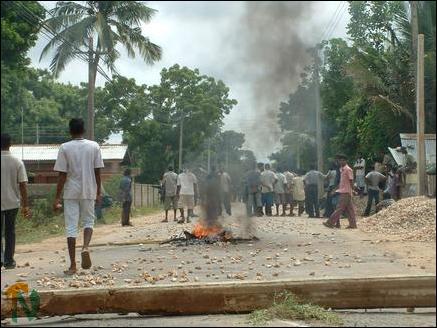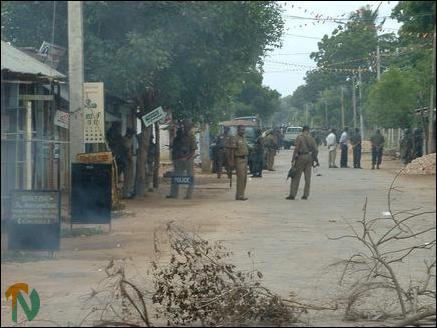
Confronting collisions in Jaffna
[TamilNet, Wednesday, 29 October 2003, 00:11 GMT]
In the wake of several recent accidents in the Jaffna peninsula in which the Sri Lanka Army (SLA) was involved, resulting in death or injury to Tamil civilians, the question being raised by the people of Jaffna is whether these accidents are caused merely by the suddenly ‘aggressive' driving of the SLA soldiers, or if this is a continuing pattern of behavior that started when the SLA brought the Jaffna peninsula under its control in 1995.
Following the mass exodus of people from Jaffna as the SLA gained control in 1995, sudden round-ups and harassment from SLA soldiers became a daily part of life in Jaffna. Check points and barbed wire barriers proliferated. Heavy military vehicles, often driven recklessly, became a common sight on Jaffna roads.
However, it was a time of war and the people were fearful of the consequences of complaining against the ‘aggressive driving’ of the SLA soldiers.
Observers familiar with the SLA’s actions in Jaffna say that revisiting the murder and rape of Krishanthy Kumarasamy, a student of Chundukuli Girls High School, in 1996, would shed more light on the SLA’s behavior. Although the incident was internationally publicized and brought focus on the atrocities committed by the SLA in Jaffna, the fact that a vehicle ‘accident’ involving the SLA was connected with the murder is not well known.
On September 7, 1996, after writing her exam papers, Miss. Kumarasamy visited the funeral home of her friend, Janaki, who died the previous day after being knocked down by a SLA truck. On her way back home, Miss. Kumarasamy was detained at the Kaithday SLA checkpoint, and the SLA later gang-raped and murdered her. It is believed that Miss. Kumarasamy, who was a brilliant and assertive student, got into an argument with the SLA soldiers at the checkpoint about the harassment she was facing from them and SLA ‘s aggressive driving that killed her friend.
Recently,
on October 3, 2003, an SLA vehicle collided with a motorcycle in Gurunagar, Jaffna, killing the two civilian riders. The SLA truck dragged their bodies several meters before coming to a stop. The SLA said that a malfunctioning brake system in their vehicle caused the accident. The incident enraged the public.
The dead youths identified as M. Lingarooban, 21, of Kondavil and M. Rasakumar, 30, of Point Pedro, were non-academic employees of the Chundukuli Girls High School. Mr. Rasakumar’s wife had given birth to their first baby only 40 days before his death in the collision.
The SLA soldiers removed the bodies of the victims and handed them over to the hospital. The SLA also removed the military vehicle from the scene, ignoring protests by the public assembled at the site of the accident. The public had argued that according to the laws of Sri Lanka, when there is an accident, the bodies or vehicles cannot be removed before a judge inspects the site.
The Police officers failed to demarcate the accident area and allowed the SLA to leave. The Police assisted the SLA in leaving no evidence that indicated SLA's involvement in the accident.
Angered by the refusal by the SLA and the Police to follow the rule of law, the public began pelting the SLA’s vehicle with stones.
The SLA and the Police began firing in the air, used teargas and baton-charged the protesters to disperse the agitated crowd. The protesters withdrew.
 Stones spread around the blocked road and burning debris
Stones spread around the blocked road and burning debrisThe following morning,
the protesters blocked the main road and burnt tires, preventing traffic. SLA forces and riot squads were rushed to the scene.
The additional magistrate in Jaffna, Mrs. Srinithi Nandasekaram, visited the site at 10:00 am on that day, 15 hours after the accident. Except for some blood and soldiers' boot marks there was no other visible evidence of the accident. The public braved threats from the SLA and gave the judge their own account of the accident. They complained to the judge at the failure of the Police personnel to demarcate the accident scene and gather evidence.
As the Judge was about to leave, members of the Sri Lanka Monitoring Mission (SLMM) arrived, and asked the public to leave the area to defuse the tension.
The public put forward two demands:
- The SLA camp which is located on the main road near the Jaffna Holy Family Convent School should be removed so that the girl students can move about without fearing harassment from the SLA, and
- SLA soldiers who are responsible for attacking the crowd should be replaced with Police officers instead to maintain order at the accident site
The SLA refused both demands. The protesting youths said that if the camp was not removed by 12 noon, they would set the camp on fire. The SLA again used teargas and baton-charged the protesters.
The youths who withdrew from the scene regrouped near the Bishop’s House and pelted the SLA soldiers and the Police on David road.
 SLA and Sri Lanka police at the scene of protestOn October 7, another 'accident' occurred in Koddady
SLA and Sri Lanka police at the scene of protestOn October 7, another 'accident' occurred in Koddady, a suburb of Jaffna town, in which a Sri Lanka Navy (SLN) truck injured a 40 year old motorcyclist. Despite the judge's order and public protests, the SLA and Police again allowed the SLN vehicle to be removed from the site of the accident.
The judge had to warn again that the police should not allow the removal of any evidence from the scene of accidents or crimes.
An 'accident' took place again on October 15 at the Mampalam junction in Ariyalai in which a SLA Buffel armored vehicle hit and injured a motorcyclist. This time, the police followed the judge's order and maintained evidence till the inquiry was completed.
Thus the public protest had to some extent succeeded in not allowing the SLA and the Police to cover up 'collisions' or 'accidents' when Sri Lanka's security forces are involved.
Jaffna residents complain that the SLA’s higher authorities do not take the loss of lives and injuries caused by the SLA’s aggressive driving in Jaffna seriously. They say the public protest was a spontaneous reaction to the tragic loss of lives and the conduct of security forces.
A senior Police officer was quoted in the Jaffna Press as saying that there were no public protests over 38 incidents in the past where civilians were injured by military vehicles.
SLA officials claimed the
media in Jaffna was biased.
These were seen as attempts to implicate the Liberation Tigers of Tamil Eelam (LTTE) as the hidden hand behind the protests. But, an LTTE official in Jaffna dismissed these claims as “plain nonsense.”
Commenting on the claims by the SLA of media bias, an editor of a Jaffna-based daily said, “Tamil media has become sophisticated and more assertive now and these accusations should be taken as compliments on the progress made by Tamil media.”
Attacks on journalists by the SLA also have increased in recent months, but Sri Lanka Army officers shrugged off this accusation, saying that the journalists were at "the wrong place at the wrong time."
"If media people were inside the mobs then you also would have had to face the baton charge and the rubber bullets." said Maj. Gen. Sarath Fonseka, in a recent meeting with journalists facilitated by the SLMM.
A long time resident of Jaffna said, "By blaming the journalists and media, the SLA is trying to advance its strategy of intimidating the public in Jaffna during this time of peace, just as it did during the time of hostilities earlier."
"To avoid negative publicity, the SLA seeks to silence the news coverage of the loss of lives caused by SLA's actions and the hardships faced by civilians and internally displaced people due to the High Security Zones (HSZ)," the resident added.








